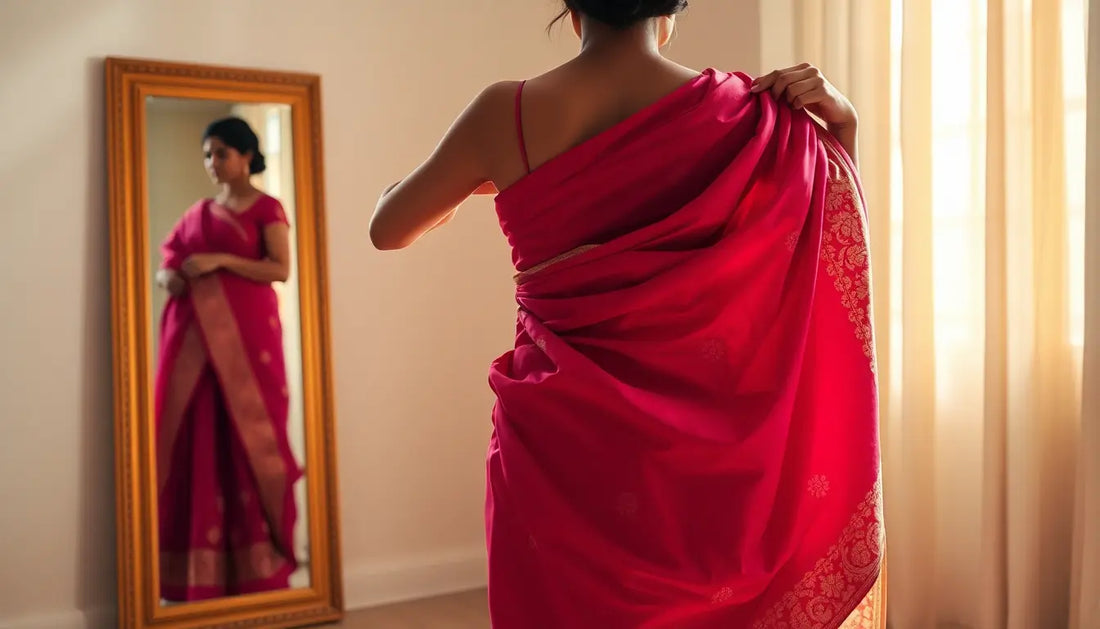Sarees are a timeless and elegant garment that have been a part of Indian culture for centuries. Draping a saree is an art form in itself, and it can be a daunting task for beginners. However, with a little practice and the right techniques, anyone can master the art of saree draping.
In this blog post, we'll explore the basics of saree draping and share some tips to help you look and feel your best in this beautiful garment.
Understanding the Saree
Before we dive into the draping techniques, it's important to understand the different parts of a saree. A saree typically consists of three main components:
- The Pallu: This is the decorative end of the saree that is draped over the shoulder.
- The Body: This is the main length of the saree that is wrapped around the waist and legs.
- The Pleats: These are the folds that are created at the waist and tucked into the petticoat.
Knowing the different parts of the saree will help you visualize the draping process and make it easier to achieve the desired look.
Choosing the Right Saree
The first step in mastering the art of saree draping is to choose the right saree for your body type and personal style. Sarees come in a variety of fabrics, colors, and designs, so it's important to select one that flatters your figure and complements your personal aesthetic.
If you're new to saree wearing, it's best to start with a lightweight fabric like georgette or chiffon, as they are easier to drape and manage. Heavier fabrics like silk or brocade can be more challenging for beginners.
When it comes to color, choose a shade that you feel confident and comfortable in. Neutral colors like black, white, or beige are always a safe bet, but don't be afraid to experiment with brighter hues or bold patterns.
Preparing for Draping
Before you start draping your saree, it's important to prepare your body and the garment itself. Here are some tips to help you get ready:
- Wear the Right Undergarments: Choose a comfortable and well-fitting petticoat or slip to provide a smooth base for the saree.
- Tuck in the Blouse: Make sure your blouse is tucked in neatly and securely, as this will help the saree drape smoothly.
- Iron the Saree: Take the time to carefully iron your saree, ensuring that it is free of wrinkles and creases.
- Measure the Saree: Measure the length of the saree and the amount of fabric you'll need to wrap around your waist. This will help you determine the right draping technique.
Mastering the Draping Techniques
Now, let's dive into the different draping techniques that you can try:
The Classic Nivi Drape
The Nivi drape is the most traditional and popular way of wearing a saree. Here's how to do it:
- Start by tucking the end of the saree into the petticoat at the waist.
- Bring the saree across your body, making sure to leave a small portion of the pallu hanging in the front.
- Wrap the saree around your waist, creating pleats as you go.
- Bring the pallu over your shoulder and adjust it to your desired look.
The Gujarati Drape
The Gujarati drape is a more modern and versatile way of wearing a saree. Here's how to do it:
- Start by tucking the end of the saree into the petticoat at the waist.
- Bring the saree across your body, creating a diagonal line from your shoulder to your waist.
- Wrap the saree around your waist, creating pleats as you go.
- Bring the pallu over your shoulder and adjust it to your desired look.
The Maharashtrian Drape
The Maharashtrian drape is a more structured and formal way of wearing a saree. Here's how to do it:
- Start by tucking the end of the saree into the petticoat at the waist.
- Bring the saree across your body, creating a vertical line down the center.
- Wrap the saree around your waist, creating pleats as you go.
- Bring the pallu over your shoulder and adjust it to your desired look.
Remember, the key to mastering saree draping is practice. Start with the basic techniques and experiment with different styles until you find the one that works best for you.
Accessorizing Your Saree
Once you've mastered the art of saree draping, it's time to accessorize! Accessories can help elevate your look and add a touch of personal style.
Some popular accessories to consider include:
- Jewelry: Statement earrings, necklaces, or bracelets can add a touch of glamour to your saree.
- Shoes: Opt for comfortable and stylish shoes, such as heels or flats, to complete your look.
- Bags: A clutch or a small handbag can be a practical and fashionable addition to your saree ensemble.
Remember, the key to accessorizing is to keep it simple and let the saree be the star of the show.
Conclusion
Mastering the art of saree draping takes time and practice, but the end result is worth it. With the right techniques and a little bit of confidence, you can look and feel your best in this timeless garment.
So, grab your favorite saree, follow these tips, and get ready to turn heads wherever you go!


